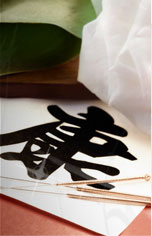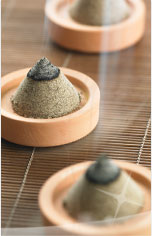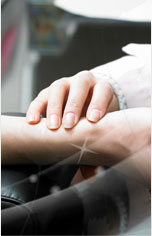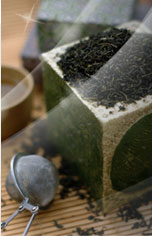| |
Acupuncture and Chinese Herbs for Pain |
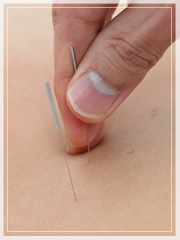
Acute and chronic pain syndromes have an enormous impact on individual, national, and global levels. In the United States, following heart disease and cancer, chronic pain is the third most common healthcare problem with the combined annual costs of lost workdays, doctor visits, hospital stays, pain-reducing drugs, and disability totaling an estimated $100 billion.
Pain itself is not a diagnosis, but an indication or a warning that there is a problem somewhere in the body. Many times, the exact location of pain points to where the problem is, as in elbow pain above an inflamed tendon of the elbow joint. The site of pain may be related to problems far away, as in leg pain resulting from a herniated disk pushing on a nerve in the back. Sometimes, pain can be a manifestation of emotional or psychological problems which cannot be found with X-rays, MRI’s, and lab tests.
The characteristics of pain give important information about what is causing the body to send this signal. Once noticed, it is important to address the underlying problem that forced the body to send the pain message, not just turn down the discomfort. Otherwise, the body will send out other warning signals until the core problem is corrected.
The most popular form of conventional treatment is through pain medication and anti-inflammatory drugs. Unfortunately, these options are only masking the pain rather than addressing the primary cause of pain. They have not only the risk of addiction but also unwanted side effects.
Acupuncture is a holistic method of encouraging the body to promote its own natural healing and to improve overall functioning. The modern scientific explains that needling the acupuncture points stimulates the body to produce natural steroids and to release endorphins. Steroids decrease inflammation, while endorphins inhibit pain. These substances are 50 to 100 times more potent in relieving pain than many prescription drugs and play an integral part in the elimination of the pain cycle.
|
| |
Mechanism of Pain in TCM |
|
According to Traditional Chinese Medicine (TCM), the proper functioning of the human body depends on Qi, the vital energy of the body. Qi and Blood flow through the meridian system, nourishing and protecting body tissues and helping them maintain their functions.
If the body has a disease or an injury, pathological symptoms will appear and affect the Zang Fu organs and meridians. When the meridian is blocked, Qi and Blood cannot flow smoothly. As a result, the affected area cannot get enough nutrition. In response, the patient feels pain, stiffness, tingling, or numbness. Hence the old TCM saying,
"If there is a blockage, there is pain. If there is no blockage, there is no pain."
Meridian system is like a network. Each meridian is connected with a specific internal organ. The organ damage may show up from the meridian, and the local blockage of the meridian can affect the internal organ as well. That is why in TCM, when treating a pain condition, the acupuncturist not only focuses on the local pain but also (sometimes more importantly) works on the whole body to restore balance and harmony of organ system.
Meridian blockage can be caused by external factors such as excessive cold, wind, dampness, dryness, fire (heat) or traumatic injury can cause blockage in meridians. It also can be caused by emotional imbalance such as anger, sadness, fear, stress, depression, as well as an internal organ deficiency or malfunction.
Figuring out what exactly causes the pain and which meridian is blocked is extremely important in treating pain. TCM treats pain by relieving Blood and Qi stagnation, increasing circulation, nourishing the tissue, nourishing deficient organs, and balancing and harmonizing the whole body. Acupuncture can correct the flow of Qi; Herbal medicine can re-establish and balance of Qi, Blood and Body Fluids in organ networks, in order to avert pathological factors.
|
|
Acupuncture Can Treat
- Arthritis / Osteoarthritis
- Back pain
- Bone spur
- Carpal tunnel syndrome
- Elbow pain
- Fibromyalgia
- Foot pain / Plantar fasciitis
- Headaches / Migraines
- Knee pain
- Muscle spasms
- Neck pain / Whiplash
- Post-surgical pain
- Sciatica, hip pain, leg pain
- Shoulder pain, frozen shoulder
- Sports / Work / Auto Injuries
- Sprains / Strains
- Tendonitis
- TMJ
|
|
NOTE: The names of organs are capitalized when referring to the entire, functional organ systems in TCM perspective: Liver, Blood, etc. The names of organs are lower-cased when referring to the distinct, biomedical organs: liver, blood, etc.
|
| |
Pain Management with Acupuncture |
|
Acupuncture is best known for its ability to treat pain successfully. Acupuncture is a safe and very effective procedure for eliminating or relieving pain.
By inserting fine, sterile needles at specific points on the body, an acupuncturist can break up blockages that have hampered the smooth flow of Qi. Proper flow of Qi helps circulation of Blood through the meridians and tissues, easing pain. Not only reducing pain and discomfort, acupuncture can also get to the root of the problem. When the original cause of the pain is corrected, the body can begin to heal on deeper levels.
According to the extensive review of the scientific evidence for acupuncture by the National Institutes of Health (NIH)1 in 1997, there is clear evidence which support efficacy of acupuncture for acute and chronic conditions; acupuncture can help these conditions by controlling pain and inflammation, facilitating circulation, enhancing the endocrine and immune function, and reducing stress. Acupuncture can also increase the effect of other therapies and reduces unwanted side effects from conventional medicine.
Upon your first visit, your acupuncturist will review your medical history; get a thorough understanding of your goals; and examine your entire body system. Once your acupuncturist gets idea on the underlying causes or problems that have not yet shown up as a symptom, and/or subtle signs of imbalance that indicate future illness, each patient will receive an individualized treatment plan based on age, past medical history, lifestyle, treatment goals and current pain status.
Treatment usually includes a combination of acupuncture, electrical stimulation, moxibustion, cupping, massage, and Chinese herbal medicine. Your acupuncturist will also give suggestions for individual lifestyle improvements regarding exercise, supplements and diet, sleeping and stress management techniques to help you improve health and decrease pain.
|
|
Benefit of Using
Acupuncture for Pain
- Stimulates the body's natural healing
- Quickly reduces pain and inflammation, and relaxes muscle
- Increases blood circulation to speed up recovery time
- Enhances the endocrine and immune function
- Maintains longer, positive results and prevents recurrence
- Reduces pain without prolonged use of drugs and surgical intervention
- Promotes physical and emotional well-being
- Fully integrates with other therapies
- Is cost effective
|
| |
Resouces
NIH Health information - Acupuncture: In Depth
Acufinder Learning Center: Pain
Acupuncture may offer real relief for chronic pain
More evidence acupuncture can ease chronic pain
|
|
|

